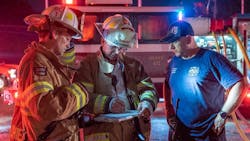In 1679, the first publicly funded fire department was established in Boston and ever since, firefighters have been looking at ways to enhance the day-to-day operations and for the tasks that they most commonly face. As technology continuously changes and improves around us, one thing remains, knowing the basics and being able to operate without technology is often overlooked.
In recent news, a cyberattack took out a staffing and payroll platform across the world and an extended outage left several of Google's websites down, which serves as a reminder that technology can have its downtimes.
Let’s take a look at an average call and see where we attempt to use technology, where we might rely on it, and any possible pitfalls we need to be aware of.
Dispatch
If you’re a career firefighter, you’re most likely sitting at the station waiting on the tones to drop. If you’re a volunteer, you probably carry around a pager. Alongside pagers, there are apps that alert us of calls as well as having additional features packed into them. Similar to the way pagers only work within certain jurisdictional limits, the apps will only work if all of the dominoes fall correctly. The call has to be forwarded to the third-party that supplies the app, their servers then have to contact your app and you have to either have a data plan that’s working or a Wi-Fi signal. Failing all of that, the call isn’t going to reach you no matter how cool the technology.
Response
The dispatch drops: “Engines 16, 2, 15, 7, Ladder 9, Medic 44, be en route to 23393 County Road 17 for a commercial fire.”
If you’re a career firefighter, at this point, you hopefully go to the mobile data terminal (MDT) in the apparatus and mark that you’re responding. If the cellular network is down or you’re in a backup truck, you might not have the MDT working properly and now you can’t properly mark yourself as responding, and furthermore other responding units might not see you on the map as they respond.
If you’re a volunteer, you might have an app that gives status as to who is or is not going to the fire. If you decide not to set a response, other responders won’t know if you’re going, so now it’s open to interpretation as to who might be responding and who isn’t. Do you wait at the station for one more responder or do you roll the apparatus out with just three personnel?
Mapping
Every smartphone today comes with mapping software — some of them even have multiple options. You open the mapping software and enter the address.
The quickest route shows seven minutes for the 2.4 mile response. Are you aware though that the route uses Industrial Boulevard, a road that is closed due to roadwork this week and isn’t reflected in maps? Are you aware that, while it might be the quickest route, it passes four stop signs, goes through a neighborhood and travels on numerous winding roads? Maybe the more effective route is 2.8 miles, but it only has one stop sign and is on a straighter and more direct path. Don’t forget, we also have the ability to use lights and sirens to possibly alert traffic of our emergent response, making it in six minutes.
Size-up and pre-planning
While responding your department utilizes pre-planning software, so you open up the pre-plan for the address. It states the pre-plan was completed seven months ago and the building occupant is a textile manufacturer. You bring up the building diagram to anticipate an interior attack and then when you arrive on scene, you find that the occupancy has recently changed to a fast food establishment and the layout is completely different. Do you now change your plan of attack? Does this change affect the way you initially react or your short report?
On scene
After you arrive on scene, you are told there might be an occupant still inside. Your initial instinct is to grab the thermal imaging camera (TIC). You grab it and make an interior push with a handline crew. You turn it on, but you’re unsure if it’s working right. Did the software on it recently get updated? Is it set to the right mode? Was it charged properly last week during the weekly check offs? As you fight the technology, you go back to what you were taught in rookie school, the good old-fashioned right-hand wall search combined with shouting out for any potential victims.
Putting it all together
As you can see from our call above, there are numerous points, both in the career and volunteer world, where technology touches our response. From the dispatch to our response, the mapping aspect and then the planning process, prior to arriving on scene. Once we’re on scene, we then have myriad tools that we can use to help assist us with our response. Most of these tools require us to ensure they are connected and up-to-date, not to mention all of them require us to be able to use them in the heat of the moment, which sometimes can get the best of us.
Back in 1679, they didn’t have the technology we have today, but they still were successful at fighting fire. Why? Because they knew their area, they knew where they were going, and they were extremely aware of the changes going on around them. Couple that with the fact that when they trained, they trained on the basics over and over, and in emergency situations, they relied on their gut instincts (the best tool you have).
The next time you jump in the rig to go get groceries or the next time you drive in your jurisdiction to go to a call, put the technology away and see if you can work just as good without it as you can if you had it at your disposal.
About the Author

Justin Rodino
Justin Rodino is a fourth-generation firefighter who has more than 20 years in the service. He began his career at Wabash Township, IN, Fire while he attended Purdue University and then served on Snoqualmie Pass Fire & Rescue as a firefighter, ski patroller and EMT. Currently, Rodino is a career lieutenant at Carroll County, GA, Fire and Rescue, which is located on the outskirts of Atlanta on busy Interstate 20. He is a hazmat technician, teaches, writes and assists with the PIO duties. On his off days, Rodino is a computer engineer, helping to write software for the fire service.
